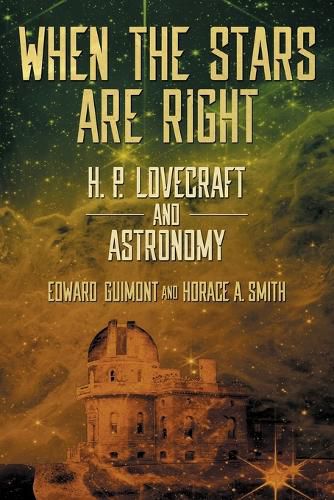Readings Newsletter
Become a Readings Member to make your shopping experience even easier.
Sign in or sign up for free!
You’re not far away from qualifying for FREE standard shipping within Australia
You’ve qualified for FREE standard shipping within Australia
The cart is loading…






This title is printed to order. This book may have been self-published. If so, we cannot guarantee the quality of the content. In the main most books will have gone through the editing process however some may not. We therefore suggest that you be aware of this before ordering this book. If in doubt check either the author or publisher’s details as we are unable to accept any returns unless they are faulty. Please contact us if you have any questions.
H. P. Lovecraft was a devotee of astronomy from the age of eleven, when he first discovered the "myriad suns and worlds of infinite space." He immediately began reading astronomy books, going to Brown University's Ladd Observatory to gaze at the stars, and doing his own astronomical observations from a 3'' telescope that his mother purchased for him. Soon he was writing astronomy columns for local newspapers.
Lovecraft's passion for astronomy is a major component of his life, thought, and literary work, but until now it has never been extensively examined. This important topic has now been treated in an exhaustive treatise written by two authorities on the subject, Edward Guimont and Horace A. Smith.
The authors probe the origin and development of Lovecraft's astronomical interests, his studies of the moon, Venus, Mars, and other objects in the solar system, his fascination with a "trans-Neptunian planet" (discovered in 1930 and named Pluto), and his conjectures as to what might lie in the farthest gulfs of the cosmos. Along the way they examine such crucial texts as "The Colour out of Space," "In the Walls of Eryx," and the handwritten astronomy journals and pamphlets that Lovecraft wrote as a boy. They make emphatically clear that astronomy was a central element in Lovecraft's life and a vital component of his weird fiction.
Edward Guimont is a professor of history at the University of Connecticut. Horace A. Smith is an emeritus professor of astronomy and astrophysics at Michigan State University.
$9.00 standard shipping within Australia
FREE standard shipping within Australia for orders over $100.00
Express & International shipping calculated at checkout
This title is printed to order. This book may have been self-published. If so, we cannot guarantee the quality of the content. In the main most books will have gone through the editing process however some may not. We therefore suggest that you be aware of this before ordering this book. If in doubt check either the author or publisher’s details as we are unable to accept any returns unless they are faulty. Please contact us if you have any questions.
H. P. Lovecraft was a devotee of astronomy from the age of eleven, when he first discovered the "myriad suns and worlds of infinite space." He immediately began reading astronomy books, going to Brown University's Ladd Observatory to gaze at the stars, and doing his own astronomical observations from a 3'' telescope that his mother purchased for him. Soon he was writing astronomy columns for local newspapers.
Lovecraft's passion for astronomy is a major component of his life, thought, and literary work, but until now it has never been extensively examined. This important topic has now been treated in an exhaustive treatise written by two authorities on the subject, Edward Guimont and Horace A. Smith.
The authors probe the origin and development of Lovecraft's astronomical interests, his studies of the moon, Venus, Mars, and other objects in the solar system, his fascination with a "trans-Neptunian planet" (discovered in 1930 and named Pluto), and his conjectures as to what might lie in the farthest gulfs of the cosmos. Along the way they examine such crucial texts as "The Colour out of Space," "In the Walls of Eryx," and the handwritten astronomy journals and pamphlets that Lovecraft wrote as a boy. They make emphatically clear that astronomy was a central element in Lovecraft's life and a vital component of his weird fiction.
Edward Guimont is a professor of history at the University of Connecticut. Horace A. Smith is an emeritus professor of astronomy and astrophysics at Michigan State University.